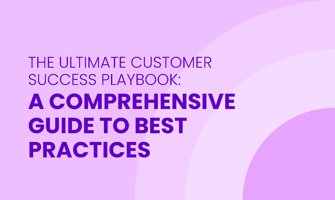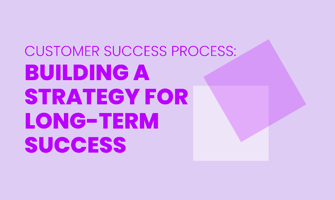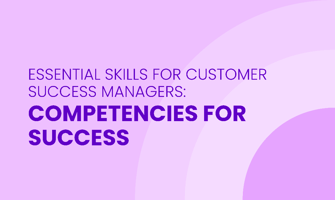Just like top sports teams trust their playbooks to win, businesses can use customer success...
Aligning Sales, Marketing, and Customer Success for RevOps Success - 10 Tips
The synergy between sales, marketing, and customer success teams is more than a strategic advantage; it's a cornerstone for thriving in today’s complex business environment.
For organizations looking to harness the full power of their revenue operations (RevOps), alignment across these domains is not just beneficial—it's essential. A well-oiled RevOps engine can drive sustainable growth, improve customer satisfaction, and optimize operational efficiency.
With that in mind, 180ops presents ten actionable tips to bolster the harmony between these critical business functions, enhancing revenue and ensuring your company doesn't just navigate but also excels in the competitive market landscape.
Importance of Alignment Between Sales, Marketing, and Customer Success for Revenue Operations Success
In the realm of RevOps, alignment across sales, marketing, and customer success is paramount. These three pillars, when operating in concert, ensure a seamless customer journey from awareness to advocacy. The result? A consistent, personalized experience that fosters deep customer satisfaction and loyalty.
Businesses that embrace this integrated approach leverage the collective strengths of each team, ensuring that every customer interaction is meaningful and aligned with broader business goals. This cohesion across functions is not just a matter of avoiding conflicts; it's about driving revenue growth through a strategic and collaborative effort that maximizes the potential of an organization's operations.
Taking a cue from RevOps' growing prominence in the business world, studies have shown that RevOps-oriented organizations are experiencing a threefold increase in revenue compared to peers who neglect this vital integration. When tackled holistically, this alignment translates into enhanced performance, with companies boasting highly aligned teams witnessing not only accelerated revenue growth rates but also up to a 72% boost in profitability.
This underscores the importance of strategic alignment, rendering it no longer an optional endeavor but a necessity for businesses aspiring to remain competitive and agile in the marketplace.
Tip 1: Establish Shared Goals and Objectives for Sales, Marketing, and Customer Success Alignment
For RevOps to truly be successful, it's essential to anchor teams with shared goals and objectives. When sales, marketing, and customer success units align on their aims, each team has a clear understanding of what success looks like and how their efforts contribute to the company's overall growth objectives.
Define common revenue and growth goals to ensure every function is pulling in the same direction.
Craft objectives that build a holistic customer lifecycle—from acquisition through to retention and expansion.
Use quantifiable targets to bring clarity and focus to these collaborative goals.
Communicate the intertwined nature of each team's success with regular updates on progress towards shared objectives.
By establishing shared goals, companies lay the groundwork for a symbiotic relationship between departments where the success of one directly amplifies the performance of the others. This alignment not only fosters unity and motivation but also makes strategic pursuit of growth opportunities more effective and cohesive.
With common destinations set, the paths carved by sales, marketing, and customer success are naturally interlaced, propelling the entire organization towards their collective targets and driving robust revenue operations.
Tip 2: Implement Integrated Technology Stacks
Seamless integration of technology stacks across sales, marketing, and customer success is a cornerstone of effective RevOps. These integrations pave the way for a streamlined flow of information, enabling better decision-making based on comprehensive revenue analytics.
Choose technology systems that allow for the synchronization of data across different platforms. Compatibility is key to ensure a smooth exchange of information.
Utilize tools that provide a unified view of customer interactions and lead intelligence, facilitating cross-departmental insights.
Invest in solutions that support automation of repetitive tasks, thereby freeing up time for strategic, high-value activities.
Ensure that your technology stack aligns with the "Minimum Viable Data" approach, focusing on critical data points for maximum clarity.
180ops' suite of revenue intelligence tools, for example, is tailored to enterprise needs, optimizing technology for a data-driven and customer-focused approach to revenue management. With the right systems in place, organizations can transcend the limitations of siloed functionalities, enabling real-time collaboration and insight sharing that fuels a proactive and informed RevOps framework.
In essence, selecting and implementing the right technology stack is not merely about adopting advanced functionalities; it's about streamlining operations to foster informed decision-making and facilitate a seamless, data-enriched collaboration environment.
Tip 3: Develop a Unified Customer Journey Map with Sales, Marketing, and Customer Success
Creating a comprehensive customer journey map is an essential step towards achieving a synergistic RevOps approach. A unified map empowers sales, marketing, and customer success teams to understand and monitor the customer's path at every stage, leading to a more coherent strategy and improved customer experience.
Begin by aggregating insights and input from all customer-facing teams to gain a multi-dimensional view of the customer lifecycle.
Identify key touchpoints, customer needs, and expectations to create a map that reflects the actual customer experience accurately.
Determine opportunities for cross-functional interventions that can enhance the customer journey and drive revenue insights.
Leverage this map to pinpoint areas for improvement and to tailor personalized interventions based on customer behavior patterns.
A united customer journey map does not only align internal teams but also lays down a path to a more strategic and customer-centric operation. It ensures that regardless of how or where a customer interacts with your company, they receive a consistent level of support, information, and engagement.
Such a map is instrumental for identifying cross-sell and up-sell opportunities, optimizing conversions along the way, and ultimately delivering a customer experience that resonates with satisfaction and loyalty.
By thoughtfully mapping out the entirety of the customer's journey, businesses are better equipped to orchestrate a harmonious and effective revenue operation strategy that resonates with revenue optimisation.
Tip 4: Adopt a Customer-First Culture in RevOps
To truly excel in RevOps, cultivating a customer-first culture is imperative. This approach should permeate every level of the organization, guiding how strategies are formulated and decisions are made.
Instill the principle that every action taken should be with the intent of adding value to the customer's experience.
Encourage teams to actively listen to customer feedback and adapt accordingly, ensuring satisfaction is at the heart of the operation.
Prioritize customer success by delivering solutions that not only meet but exceed expectations, fostering a sense of trust and loyalty.
Align internal incentives and reward systems with customer success milestones to reinforce a customer-centric mindset.
Adopting a customer-first culture isn't just about improving customer interactions; it's an overarching philosophy that, when ingrained within RevOps, transforms the way products are developed, services are delivered, and relationships are managed. It ensures that customers' needs and preferences drive innovation and operational changes.
By putting the customer at the core of all operations, companies pave the way for sustainable growth and a competitive advantage. After all, satisfied customers become advocates for your brand, and in the interconnected world of sales, marketing, and customer success, their endorsement can be the most powerful driver of new business.
Tip 5: Align Metrics and KPIs Across Sales, Marketing, and Customer Success
Metrics and key performance indicators (KPIs) are critical in measuring the health of a company's revenue operations. They provide essential data points that inform strategies and tactics for each team involved.
Select KPIs that reflect the shared objectives of sales, marketing, and customer success, ensuring everyone is gauged by a common standard.
Utilize revenue metrics such as customer lifetime value (CLV), average revenue per account (ARPA), and churn rates to align with overarching business goals.
Facilitate transparency by sharing performance data across teams to drive a healthy competitive spirit and promote cross-functional learning.
Regularly review and adjust KPIs to better match the evolving landscape of customer requirements and market trends.
Aligning metrics is not simply a means of tracking performance; it acts as a unifying language that enables different teams to understand their impact on the entire customer journey and revenue process.
When sales, marketing, and customer success departments rally around a common set of benchmarks, the entire organization moves towards synchronized, goal-driven initiatives.
Establishing congruent KPIs is a strategic move that drives collaboration and ensures that every touchpoint in the customer experience is informed by a shared understanding of what constitutes success in RevOps.
Tip 6: Facilitate Regular Communication and Collaboration Through Functional Meetings
Quality communication is the lifeblood of effective RevOps. Regular, functional meetings between sales, marketing, and customer success teams represent a vital opportunity to ensure alignment, share insights, and address challenges in a collaborative environment.
Schedule consistent cross-departmental meetings to discuss strategies, share successes, and highlight areas for alignment.
Foster open dialogue that encourages the exchange of ideas and feedback, promoting an atmosphere where all teams have a voice.
Use these meetings to review customer feedback and operational data, allowing teams to make informed decisions collectively.
Embed the principles of the RevOps framework to emphasize the interconnectedness of every function's role in the overall success of the company.
Through these recurring collaborative sessions, each team not only gains an understanding of how their function contributes to the larger goals but also appreciates the challenges and triumphs of their colleagues in different areas.
This cultivates a culture of mutual respect and teamwork, which is integral for breaking down silos and nurturing a productive and cohesive work environment.
These meetings aren't just another item on the calendar; they are a cornerstone of operational efficiency where the combined strengths of each team are leveraged to drive continuous improvement and achieve revenue optimisation.
Tip 7: Create Feedback Loops for Continuous RevOps Development and Enablement
Integrating robust feedback loops creates a dynamic RevOps environment where continuous improvement becomes part of the organizational DNA.
Set up processes for collecting and analyzing feedback from all customer touchpoints to derive actionable insights.
Encourage the sharing of customer experiences across departments to foster empathy and an understanding of the customer's perspective.
Implement regular reviews of customer interactions and revenue analysis to identify trends and performance gaps.
Involve all teams in the problem-solving process, using feedback to guide training, resource allocation, and strategy adjustments.
Feedback loops are pivotal, not only for addressing immediate issues but for driving long-term development in the RevOps framework. By systematically capturing and responding to customer and internal team feedback, companies can sharpen their competitive edge through rapid iteration and responsiveness.
In an ecosystem where customer expectations are perpetually rising, establishing feedback loops ensures that your RevOps strategy is perpetually evolving, thereby guaranteeing satisfaction and maintaining a pulse on the burgeoning trends that define success in your industry.
Tip 8: Invest in Cross-Training and Development for RevOps Framework Leadership
Cross-training is an investment that pays dividends in the realm of RevOps. By broadening the understanding each team member has of their colleagues' roles and challenges, a company fosters a workforce that is agile, empathetic, and equipped to lead with a comprehensive view of the business.
Develop a cross-training program that encompasses the intricacies of sales, marketing, and customer success functions.
Encourage ongoing learning and professional development to keep teams adept with the latest tools and methodologies.
Share best practices and successes across teams, creating a knowledge-sharing environment that sparks innovation and joint problem-solving.
Recognize and reward multi-skilled individuals who can contribute across various domains, further motivating the adoption of a holistic skill set.
Leaders with a well-rounded understanding of multiple functions bring a valuable perspective to RevOps, one that allows for integrated strategies and nuanced insights. Moreover, team members equipped with a broader knowledge base are often more adept at identifying opportunities for improvement and innovation within the revenue stream.
When employees step outside their silos to learn about the workflows and challenges of their counterparts, it not only promotes empathy but also aligns practices and goals, paving the way for a more effective and unified approach to RevOps.
Tip 9: Choose the Right RevOps Software: Leverage Predictive Analytics and Data-Driven Insights
Choosing the right technology is pivotal in amplifying the capabilities of a revenue operations strategy. The ideal RevOps software should enhance predictive analytics capabilities and provide insightful, data-driven guidance.
Opt for solutions like 180ops' suite of RevOps tools, which are built upon AI and machine learning frameworks—offering clear, actionable insights from complex data sets.
Seek platforms that integrate seamlessly with existing systems and promote data harmonization to ensure consistency and accuracy.
Prioritize software with advanced analytics features that can predict customer behaviors, sales trends, and market opportunities.
Evaluate the software's ability to deliver personalized revenue insights that are critical for fine-tuning strategies and connecting with customers more effectively.
The right RevOps software serves as the nexus between your teams, data, and strategy. It provides a level of analysis that is impossible to replicate manually, revealing insights that might otherwise remain hidden. Such technology ensures that decisions are not based on intuition but are guided by robust, precise analysis.
By carefully choosing the appropriate RevOps software, companies can transform their approach from reactive to proactive, allowing them to anticipate market shifts, optimize customer experiences, and drive thoughtful, informed discussions about future revenue opportunities.
Tip 10: Adopt Agile Methodologies for Revenue Operations
Agile methodologies, often associated with software development, can also be a transformative force for RevOps. These practices empower teams to rapidly adapt to changes, enhance collaboration, and focus on the delivery of customer value.
Apply agile principles by breaking work into smaller, manageable segments with the flexibility to pivot as needed.
Enable cross-functional teams to work in iterative cycles, regularly delivering improvements and responsive changes.
Foster a culture of experimentation, learning from successes and failures alike to refine strategies over time.
Embrace tools and processes that allow for real-time response and flexibility in the execution of RevOps tasks.
By embedding agile methodologies into RevOps, businesses can keep pace with the swiftly changing demands of the marketplace and customer needs. Agile RevOps become synonymous with resilience and responsiveness, qualities that are essential in a business landscape marked by rapid evolution and competition.
Agility in revenue operations isn't just about speed; it's about maintaining a fluid and continuous cycle of performance, feedback, and improvement. This enables a proactive and anticipatory approach to revenue management, ensuring that RevOps leaders are always one step ahead in navigating and capitalizing on market dynamics.
Conclusion
The alignment of sales, marketing, and customer success is more than a strategic advantage; it's a critical factor for business results. By adopting these ten tips, professionals can transform their company's revenue operations into a unified force, driving clarity, efficiency, and growth.
The integration of shared goals, technology, customer insight, and agile practices create a RevOps ecosystem that is dynamic, flexible, and poised for success. And with solutions like those offered by 180ops, businesses have access to the technological support necessary to navigate this complex landscape with confidence and insight.
The road to RevOps excellence is an ongoing journey, but with a concerted effort to foster alignment and collaborate across all aspects of the customer lifecycle, companies can achieve unprecedented levels of operational efficiency and profitability. This holistic approach to revenue management is at the heart of modern business success, reinforcing the philosophy that when teams work in concert, the entire organization thrives.
FAQ
How can businesses achieve RevOps alignment across Sales, Marketing, and Customer Success teams?
Businesses can achieve RevOps alignment by establishing shared goals, integrating technology stacks, and fostering a culture of collaboration among Sales, Marketing, and Customer Success teams. This ensures that all departments are working towards common objectives, enhancing overall operational efficiency and customer satisfaction.
What are the benefits of leveraging technology for RevOps alignment in a business setting?
Leveraging technology for RevOps alignment involves implementing unified CRM systems, analytics tools, and communication platforms. This integration enables real-time data sharing, streamlined workflows, and more cohesive strategies across departments, ultimately leading to improved decision-making and business outcomes.
In what ways can coaching contribute to the success of RevOps alignment?
Coaching plays a crucial role in RevOps alignment by developing the skills and knowledge of team members across departments. Regular training sessions, workshops, and one-on-one coaching help align methodologies, enhance teamwork, and ensure that everyone understands their role in achieving the company's revenue goals.
How does the pre-sales process impact RevOps alignment and overall business success?
The pre-sales process is critical to RevOps alignment as it sets the tone for the customer journey. Ensuring that Sales, Marketing, and Customer Success teams are aligned during this phase helps in creating a seamless experience for potential customers, increasing the likelihood of conversion and long-term loyalty.
What strategies can businesses implement to ensure effective RevOps alignment?
To ensure effective RevOps alignment, businesses can adopt agile methodologies, create cross-functional teams, establish clear communication channels, and regularly review and adjust strategies based on performance data. Emphasizing a customer-centric approach and aligning KPIs across departments are also key strategies for maintaining alignment and driving business success.




